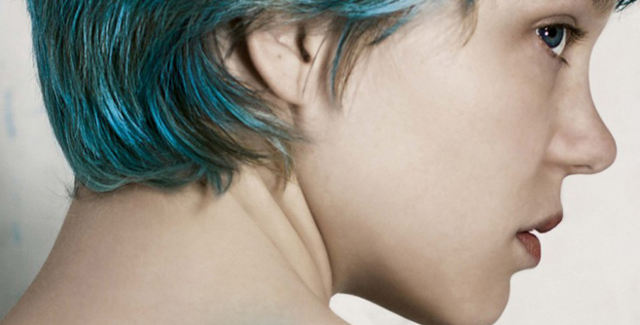Blue Is the Warmest Color Sexual Identity Struggles

Let me begin by giving my opinion on all the controversies surrounding the seven-minute-long lesbian sex scene in Blue Is the Warmest Color. My opinion is that it's not worth my time to have opinions about silly controversies.
The French title of Abdellatif Kechiche's new movie, which is playing at the newly-opened FilmScene beginning Dec. 6, translates as The Life of Adèle, which I prefer to Blue Is the Warmest Color, an artsy mishmash of Fifty Shades of Gray and Orange Is the New Black. The movie really is about the life of Adèle, and by that I mean you feel your way into her existence in an almost unprecedented way.
The story opens in school, as Adèle and her fellow high-schoolers try to parse a text by Pierre de Marivaux, the great French novelist and metaphysician of love. They fumble awkwardly with it, as we always do when we're asked to interpret a work of profundity. Adèle soon finds that she's in the same boat with herself: She has to interpret her own unfathomable erotic depths. The movie follows Adèle in her discovery of her lesbian sexuality and jumps through several years of her love affair with Emma, whose dyed-blue hair inspires the English title of the movie.
Great coming of age movies—Louis Malle's Murmur of the Heart, Kimberly Peirce's Boys Don't Cry—tend to find a way of making sexual identity feel intensely intimate yet utterly strange. But what makes Blue such a unique emotional experience is how Kechiche gets us to experience Adèle in so many ways simultaneously.
He often portrays Adèle as a child, almost like she's your child. He shows her stuffing her mouth with candy and trying to straighten her unruly hair. Multiple scenes are no more than her sleeping face. Even when we suddenly encounter her as a young adult, she's surrounded by children in her work as a kindergarten teacher.
Kechiche also portrays Adèle as an erotic object. The male director has taken some hits for staging her, particularly in the sculptural sex scenes, for his—and our—pleasure. But the objectification of Adèle is important. Let's face it: She is beautiful. And her being attractive is important for her character, just like it's important for us to experience others as beautiful.
Finally, Kechiche portrays Adèle as us. We fall in love not only with her but through her. In the final quarter of the movie, when Adèle is left desolate, I found myself subject to a similar desolation, something bigger than loneliness, where my own intimate memories filled the gaping emotional spaces on the screen.
In one of those final moments, as Adèle is crying in front of her estranged lover, snot runs down her nose. Anybody who's been through the ringer of love knows just how she feels. But you also want to wipe her nose. That scene crystallizes our experience of her as simultaneously child, lover and self. Any director would have demanded tears, but the snot is a touch of brilliance.
Blue isn't without its faults. A scene that involves the symbolism of eating oysters is, let's just say, less than subtle. Worse, when the movie strays into philosophical and political issues, particularly pertaining to the conflicting social classes of its main characters, it verges on the banal Marxism that afflicts many French films. Luckily, such moments are rare.
As much as its sex scenes get talked up, the movie is really a love story, with all love's accompanying spiritual and physical chaos. The long sex scenes between the main characters work dramatically because anybody who's been in love knows how the alpha and the omega of the universe can be synonymous with the body of your beloved. But the most intense erotic moments take place outside the bedroom, in charged conversations, on a park bench, at a picnic, even when they're alienated from each other and yet still crackling with eroticism.
The movie's believability is largely due to the outstanding performances of Adèle Exarchopoulos as Adèle and Léa Seydoux as her blue-haired lover Emma. I fell in love with both of them. I fell in love through both of them. It's no surprise that the Palm d'Or at the Cannes Film Festival was awarded to Kechiche and them as a trio.
Let me end by saying that I saw Blue Is the Warmest Color at Filmscene's newly-opened venue. In a sold-out theater, with exposed brick walls, I sat with a glass of wine and watched lesbian sex and a heartbreaking love story on a surprisingly big screen. What more do you want?
Scott Samuelson teaches philosophy at Kirkwood Community College and blogs about music with his son at billyanddad.wordpress.com.
Source: https://littlevillagemag.com/talking-movies-looking-beyond-the-controversy-of-blue-is-the-warmest-color/
0 Response to "Blue Is the Warmest Color Sexual Identity Struggles"
Postar um comentário